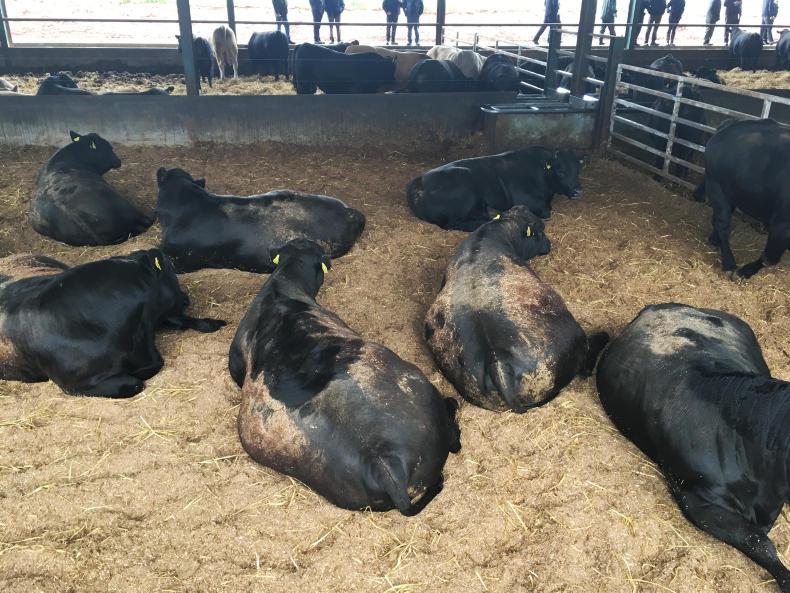The mood is good among Scottish beef farmers at the moment. Finishing beef in the highest-priced beef market in the EU, they remain quietly confident about the future of the industry. The Scottish beef brand is a huge success story, with worldwide recognition of the product. The strength of this brand has enabled Scottish beef farmers to achieve a consistently higher price than the rest of the UK.
The breeding herd is running at 424,000 suckler cows and the average herd size is 47. Scotland has a number of very large cattle holdings and, in 2015, 13.5% of holdings accounted for over half the cattle population.
The Scottish beef industry comes together every two years to host a Scotbeef event where industry and commercial companies run an open day on a farm for Scottish beef farmers. This year the event was held on Fans Farm, just outside Kelso in the Scottish borders.
The farm is managed by Douglas Stewart and consists of 2,430 acres across three farms. Cropping includes winter oats, winter barley, spring barley and 350 acres of specialist seed potato production. The cattle are grazed on 468 acres of permanent pasture and 315 acres of rough grazing, with 120 acres cut twice for silage each year.
As with many large-scale Scottish and UK holdings, the cattle provide farmyard manure for the arable crops, which in turn provide barley for finishing cattle and straw for bedding. The farm’s only imported feed is in the form of soya as a protein source for weanlings and some high-mag rolls for cows in spring.
Why Aberdeen Angus?
Twenty-five years ago the farm was buying in replacements from the dairy herd and breeding with terminal bulls. Douglas said: “It just became increasingly difficult to source the right type of heifer for our system. We also had a few health issues. We had some pedigree Aberdeen Angus in the past and we knew what they could do so went down that route and we have had no regrets.
“We now have a more consistent cow and have more control over breeding our own replacements rather than depending on the dairy industry.”
Douglas calves his heifers at two years of age and operates a strict breeding policy with the herd. A ruthless culling policy has seen 92% of the herd calve in six weeks in 2017, with all cows calving in April and May.
Bull power
The 14 stock bulls on the farm go through a health check before turnout with cows each year which includes a semen test, feet exam, BCS, testicles and sheath check. Mature bulls run with 55 cows while young bulls run with 20 cows in their first year. “We buy all our bulls privately and want them lean, not fat. You can’t buy lean bulls at bull sales. Lean bulls are ready to work and last longer on their feet.”
Breeding
Cows are culled at 10 years of age when cull value is still fairly good. Eighty heifers are kept for the breeding herd each year. The thinking is that cull cows are worth the same as 14-month-old heifers so they are sold before they become too old to put on flesh. Using Angus sires has reduced calving difficulty significantly on the farm and all assists are recorded so that decisions can be made around culling. Twenty-four cows were assisted out of 400 in 2017, with the vet called twice. An annual Johne’s disease blood test has been completed since 2005, with all positives culled. The herd has been closed since 1997 and only stock bulls are bought in now from known sources. A huge emphasis is placed on hygiene around calving and cows and calves are generally turned out within 24 hours of calving.
Weaning
Calf creep is introduced in August and first-calved heifers are weaned first in September to allow them regain some condition prior to winter months. Cows are weaned in October and housed on 1 December. Cows are wintered on silage and straw and weanlings are fed silage and a barley-based ration before going ad-lib in March-April at 11 to 12 months. Bulls averaged 392kg carcase and grossed £1,367 at 348p/kg (€1,646). Douglas said: “We were really disappointed with our steer performance in the wet summer of 2012 and made the switch to bulls. You cannot ignore the feed efficiency and growth rates of these animals.”
Feeding management
Over the winter months, bull calves are fed 1.7kg of a barley- and soya-based ration along with 12kg of silage fed via a diet feeder daily. Straw is also made available in feeders.
Meal is gradually stepped up and by 1 April bulls will be consuming 11kg of concentrate before going on ad-lib ration in mid April. They are slaughtered at 700kg to produce a carcase of 392kg at 420 days. Assuming a 45kg liveweight, this equates to a 1.56kg/day liveweight gain from birth, which is quite impressive.
Comment
Fans farm is a very good example of how a beef and arable enterprise can complement each other. Douglas has adapted his breeding system to suit what the market wants in terms of carcase weight and he is in constant contact with his processor about his bulls and market spec. Keeping his herd closed has brought many advantages from a health point of view and the high standard of management inside the farm gate means that the farm is well placed to meet any challenges in a post-Brexit era.
Farm facts
Fans Farm, Douglas Stewart.
Farm size: 2,430 acres.
Cattle area: 903 acres.
Cow numbers: 400.
Breed: Aberdeen Angus.
System: 14-month bulls and 15-month heifer.






 This is a subscriber-only article
This is a subscriber-only article











SHARING OPTIONS: